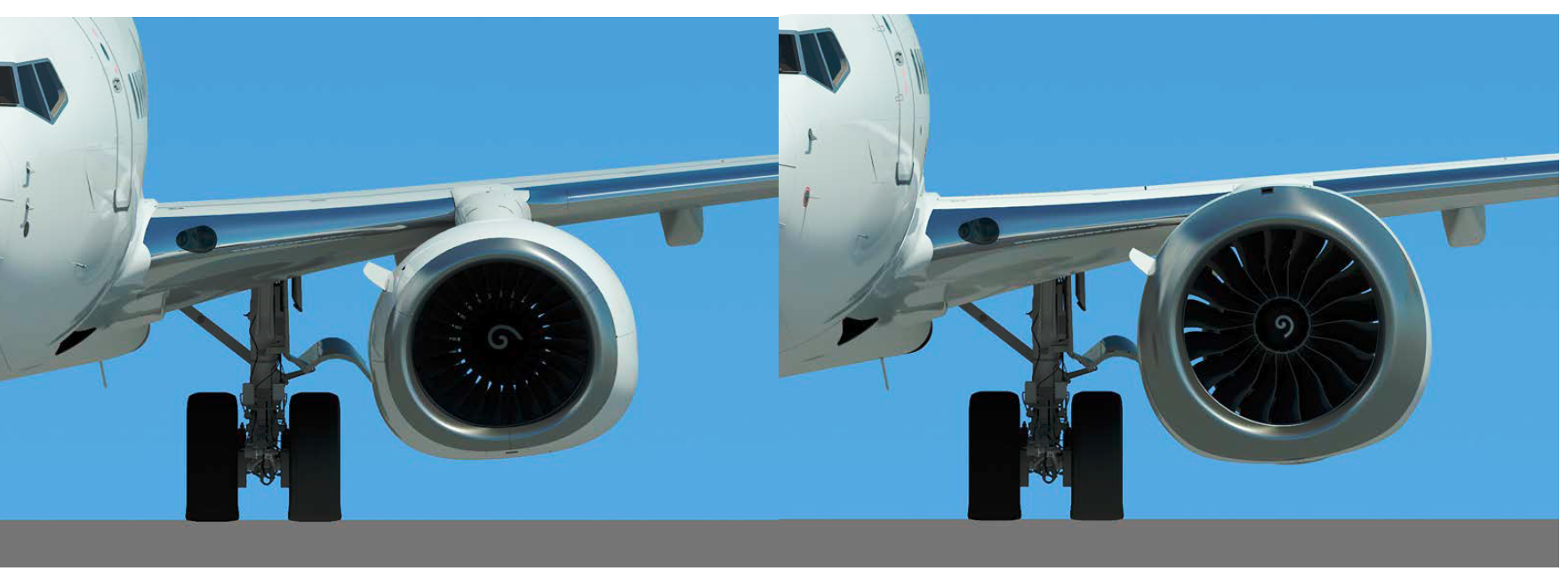The background to Boeing’s 737 MAX automatic trim The automatic trim we described last week has a name, MCAS, or Maneuvering Characteristics Automation System. It’s unique to the MAX because the 737 MAX no longer has the docile pitch characteristics of the 737NG at high Angles Of Attack (AOA). This is caused by the larger engine nacelles covering the higher bypass LEAP-1B engines.The nacelles for the MAX are larger and placed higher and further forward of the wing, Figure 1.
Figure 1. Boeing 737NG (left) and MAX (right) nacelles compared. Source: Boeing 737 MAX brochure.By placing the nacelle further forward of the wing, it could be placed higher. Combined with a higher nose landing gear, which raises the nacelle further, the same ground clearance could be achieved for the nacelle as for the 737NG.
The drawback of a larger nacelle, placed further forward, is it destabilizes the aircraft in pitch. All objects on an aircraft placed ahead of the Center of Gravity (the line in Figure 2, around which the aircraft moves in pitch) will contribute to destabilize the aircraft in pitch.
Figure 2. The 737-800 (yellow) overlaid on the 737 MAX 8 (purple), with the line denoting the CG in pitch. Source: Leeham Co. and 737 ACAP.The 737 is a classical flight control aircraft. It relies on a naturally stable base aircraft for its flight control design, augmented in selected areas. Once such area is the artificial yaw damping, present on virtually all larger aircraft (to stop passengers getting sick from the aircraft’s natural tendency to Dutch Roll = Wagging its tail).
Until the MAX, there was no need for artificial aids in pitch. Once the aircraft entered a stall, there were several actions described last week which assisted the pilot to exit the stall. But not in normal flight.
The larger nacelles, called for by the higher bypass LEAP-1B engines, changed this. When flying at normal angles of attack (3° at cruise and say 5° in a turn) the destabilizing effect of the larger engines are not felt.
The nacelles are designed to not generate lift in normal flight. It would generate unnecessary drag as the aspect ratio of an engine nacelle is lousy. The aircraft designer focuses the lift to the high aspect ratio wings.
But if the pilot for whatever reason manoeuvres the aircraft hard, generating an angle of attack close to the stall angle of around 14°, the previously neutral engine nacelle generates lift. A lift which is felt by the aircraft as a pitch up moment (as its ahead of the CG line), now stronger than on the 737NG. This destabilizes the MAX in pitch at higher Angles Of Attack (AOA). The most difficult situation is when the manoeuvre has a high pitch ratio. The aircraft’s inertia can then provoke an over-swing into stall AOA.
To counter the MAX’s lower stability margins at high AOA, Boeing introduced MCAS. Dependent on AOA value and rate, altitude (air density) and Mach (changed flow conditions) the MCAS, which is a software loop in the Flight Control computer, initiates a nose down trim above a threshold AOA.
It can be stopped by the Pilot counter-trimming on the Yoke or by him hitting the CUTOUT switches on the center pedestal. It’s not stopped by the Pilot pulling the Yoke, which for normal trim from the autopilot or runaway manual trim triggers trim hold sensors. This would negate why MCAS was implemented, the Pilot pulling so hard on the Yoke that the aircraft is flying close to stall.
It’s probably this counterintuitive characteristic, which goes against what has been trained many times in the simulator for unwanted autopilot trim or manual trim runaway, which has confused the pilots of JT610. They learned that holding against the trim stopped the nose down, and then they could take action, like counter-trimming or outright CUTOUT the trim servo. But it didn’t. After a 10 second trim to a 2.5° nose down stabilizer position, the trimming started again despite the Pilots pulling against it. The faulty high AOA signal was still present.
How should they know that pulling on the Yoke didn’t stop the trim? It was described nowhere; neither in the aircraft’s manual, the AFM, nor in the Pilot’s manual, the FCOM. This has created strong reactions from airlines with the 737 MAX on the flight line and their Pilots. They have learned the NG and the MAX flies the same. They fly them interchangeably during the week.
They do fly the same as long as no fault appears. Then there are differences, and the Pilots should have been informed about the differences.

